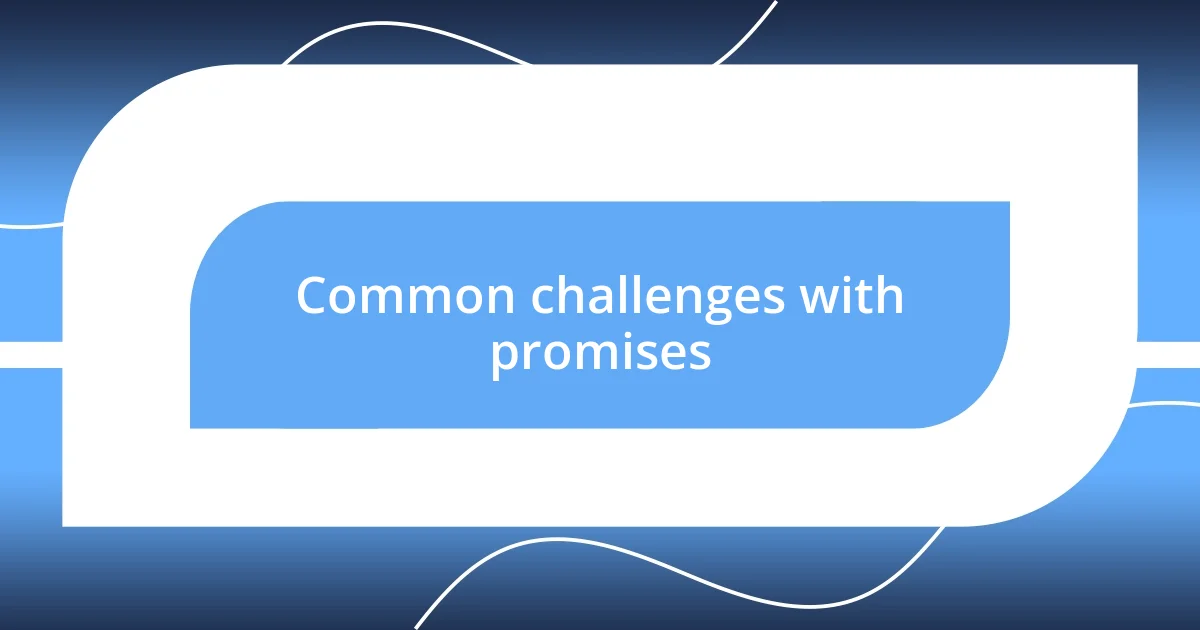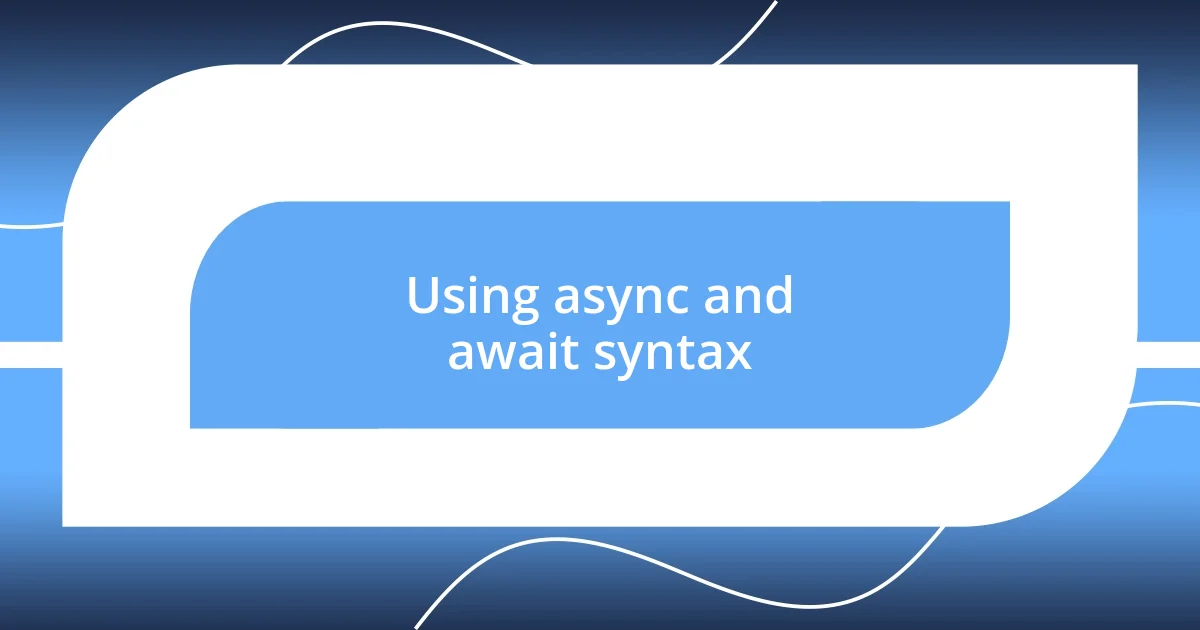Key takeaways:
- Understanding the three promise states (pending, fulfilled, rejected) helps manage expectations and organize asynchronous code effectively.
- Utilizing
async/awaitsyntax simplifies promise handling, allowing for clearer, more readable code and improved error handling. - Best practices for using promises include returning promises in
then()handlers, avoiding nested promises, and keeping functions single-purpose for better clarity and maintainability.

Understanding JavaScript promises
Understanding JavaScript promises can feel like unraveling a mystery at first. I remember when I encountered my first promise in code – it took me a moment to grasp the concept of asynchronous behavior and how promises represent the eventual completion (or failure) of an operation. It’s like waiting for a friend to show up; you know they will arrive, but you’re not sure exactly when.
Promises are a fascinating way to handle asynchronous tasks in JavaScript. They provide a cleaner alternative to callback functions, which can often lead to “callback hell.” Have you ever felt overwhelmed trying to manage multiple nested callbacks? I certainly have! Promises allow you to chain operations and catch errors more gracefully, which makes debugging a lot easier, especially when the stakes are high, like in production environments.
It’s important to understand that a promise can be in one of three states: pending, fulfilled, or rejected. I find it helpful to visualize these states as a traffic light; green means it’s complete, red means it has failed, and yellow signifies that it’s still working on it. The clarity in these states helps manage expectations when waiting for data, transforming what could be a chaotic experience into a structured flow. Don’t you think having that level of organization in code is both a relief and empowering?

Common challenges with promises
Handling JavaScript promises comes with its own set of challenges that can be quite tricky. One instance that stands out in my memory is a time when I forgot to return a promise in a chain. As a result, the subsequent .then() didn’t execute as expected, leaving me confounded. It’s moments like these that remind me how easily we can overlook the basics, despite our confidence.
Here are some common challenges I’ve encountered with promises:
- Chaining Issues: Forgetting to return the promise in a chain can lead to undefined behavior.
- Error Handling: Not properly using
.catch()could allow unhandled promise rejections to slip through unnoticed. - Nested Promises: Getting lost in multiple layers of promises can mimic callback hell, making code harder to read.
- Race Conditions: When two promises resolved at different times, the order of execution can often lead to unexpected results, which can be frustrating to debug.
Each of these challenges serves as a reminder to stay vigilant and organized when working with promises. I often find myself double-checking my code to ensure I’m following best practices.

Effective promise chaining methods
Effective promise chaining methods can greatly enhance how we handle asynchronous operations in JavaScript. I’ve found that one effective technique is to maintain clarity by returning the promise in every .then() method. I vividly recall a project where I missed this step, causing the entire sequence to fail. Ensuring each promise is returned has since been an unbreakable rule in my coding practices—it not only solidifies readability but also prevents those frustrating pitfalls.
Another approach that has served me well is using async/await, which simplifies promise chaining greatly. This method feels more synchronous and allows for easy error handling with try/catch blocks. I remember transitioning to this style during a particularly convoluted feature development. It was enlightening to see how much cleaner my code became! It was like cleaning up a cluttered desk; everything suddenly felt more organized, and my thinking was sharper.
When it comes to promise chaining, it’s crucial to be mindful of the order in which you handle the operations. I once faced a situation where I resolved a promise that depended on another one. The result was not only unexpected but also led to a series of cascading errors that took a significant time to debug. Since then, I’ve crafted a habit of carefully planning my promise sequence, often jotting down a flowchart to visualize the dependencies. This foresight can save substantial headaches down the line.
| Method | Description |
|---|---|
| Returning Promises | Always return the result of promises in chaining to ensure proper flow. |
| Async/Await | Use async functions to simplify promise chaining and error handling. |
| Mindful Ordering | Be aware of the sequence in which promises are resolved to prevent errors. |

Using async and await syntax
Using async and await syntax has completely transformed my approach to handling asynchronous code. I still remember the first time I refactored a complicated promise chain into an async function. The sense of relief I felt as I eliminated that confusing .then() jungle was palpable. Why wrestle with cluttered callbacks when async/await makes your code not only cleaner but also easier to read?
When I first started incorporating async and await, I often forgot that await can only be used inside async functions. That little detail tripped me up more times than I care to admit. It’s like trying to jam a square peg into a round hole; you realize there’s a reason for those rules after a few frustrating attempts.
What truly resonates with me about using async/await is how it allows for straightforward error handling. I vividly recall struggling with multiple .catch() statements scattered throughout my code. The switch to try/catch blocks felt like a breath of fresh air; everything was suddenly more coherent. If we can embrace this simplicity, why wouldn’t we? It streamlines the error-catching process and makes the flow of data clearer, and I’ve found that clarity is crucial in maintaining an organized thought process while coding.

Error handling in promises
When it comes to error handling in promises, I’ve found that leveraging the .catch() method is an absolute game-changer. I once overlooked this aspect completely, leading to a backlog of unhandled rejections that left my application in disarray. It was a stark reminder of how essential it is to wrap up potential failures, and now, I consider .catch() my safety net, catching any unexpected errors and letting me address them gracefully.
Another technique that has served me well is using the Promise.all() method, especially when I need to run multiple promises in parallel. I remember a project where I was fetching data from several APIs simultaneously. Initially, I stumbled through handling errors individually, but once I implemented Promise.all(), I could handle failures collectively. If one of the promises failed, it notified me right away, allowing me to log or retry without sifting through each one individually. Isn’t it satisfying to see after-the-fact improvements that save time and frustration?
It’s also immensely helpful to think about custom error messages, which can guide you when debugging. Early in my coding journey, standard error messages frustrated me because they rarely reflected the actual issue. I started taking extra minutes to throw custom errors within my promise rejections, and it transformed my debugging process. Now, when an error occurs, it speaks to me in a language I understand, allowing me to pinpoint and resolve issues much faster. Isn’t it reassuring to know exactly where things went wrong?

Real-world examples of promises
I remember a particular instance when I was building a feature that involved loading user data dynamically. Initially, I relied on chained promises to sequence my API calls, which created a lot of visual clutter in my code. It felt chaotic and overwhelming, like trying to follow a convoluted map. When I pivoted to using Promise.all(), everything changed. Suddenly, I could request multiple users at once and handle the responses with grace. Why did I ever hesitate? The efficiency and clarity that emerged from this method made me wonder how I’d managed without it.
One day, during a team project, we encountered a major issue when one of our API calls failed silently due to an unhandled promise rejection. That was a frustrating day. It was like being in a dark room searching for a light switch that wasn’t there. We turned to the .catch() method and began crafting meaningful error reports. The transformation in our debugging experience was incredible; we went from scrambling in the dark to having shining beacons guiding us to the root of the problem. How important is it to have those beacons in our coding journeys?
On another occasion, I experimented with fallback mechanisms using promises. While fetching data from an external service, I included a secondary API call in the .catch() block. When the first call failed, the second one effectively kicked in, ensuring that the user experience remained seamless. I felt an immense sense of accomplishment seeing that protective layer work as intended, like a safety net for my fragile application. Isn’t it rewarding to add such resilience to our projects?

Best practices for JavaScript promises
When working with JavaScript promises, one of my best practices is to always return promises from then() handlers. Early on, I sometimes forgot to return them, leading to unexpected behavior that was both confusing and frustrating. By ensuring that I return a promise, I can chain additional logic effectively and maintain clarity in my code flow. This simple habit transformed my approach to asynchronous programming—don’t you just love it when a small change makes such a big impact?
Another essential practice is to avoid nesting promises whenever possible. I vividly recall a project where I found myself caught in a heavy web of nested calls, making my code a nightmare to read. It felt like wading through mud, struggling to keep track of which promise belonged where. Switching to a flat promise structure with better chaining not only tidied up my code but also improved its maintainability. Have you ever experienced that overwhelming moment when you realize simplicity can save you so much headache?
Lastly, I always try to keep my promise-based functions focused and single-purpose. In one of my earliest projects, I attempted to pack too much functionality into a single promise function, which left everything feeling chaotic and difficult to manage. Narrowing down each function to perform one task—like fetching data or performing a computation—has made my code cleaner and much easier to test. This practice reminds me of the joy of clarity, making my development process smoother. Isn’t it empowering to feel in control of your code again?














